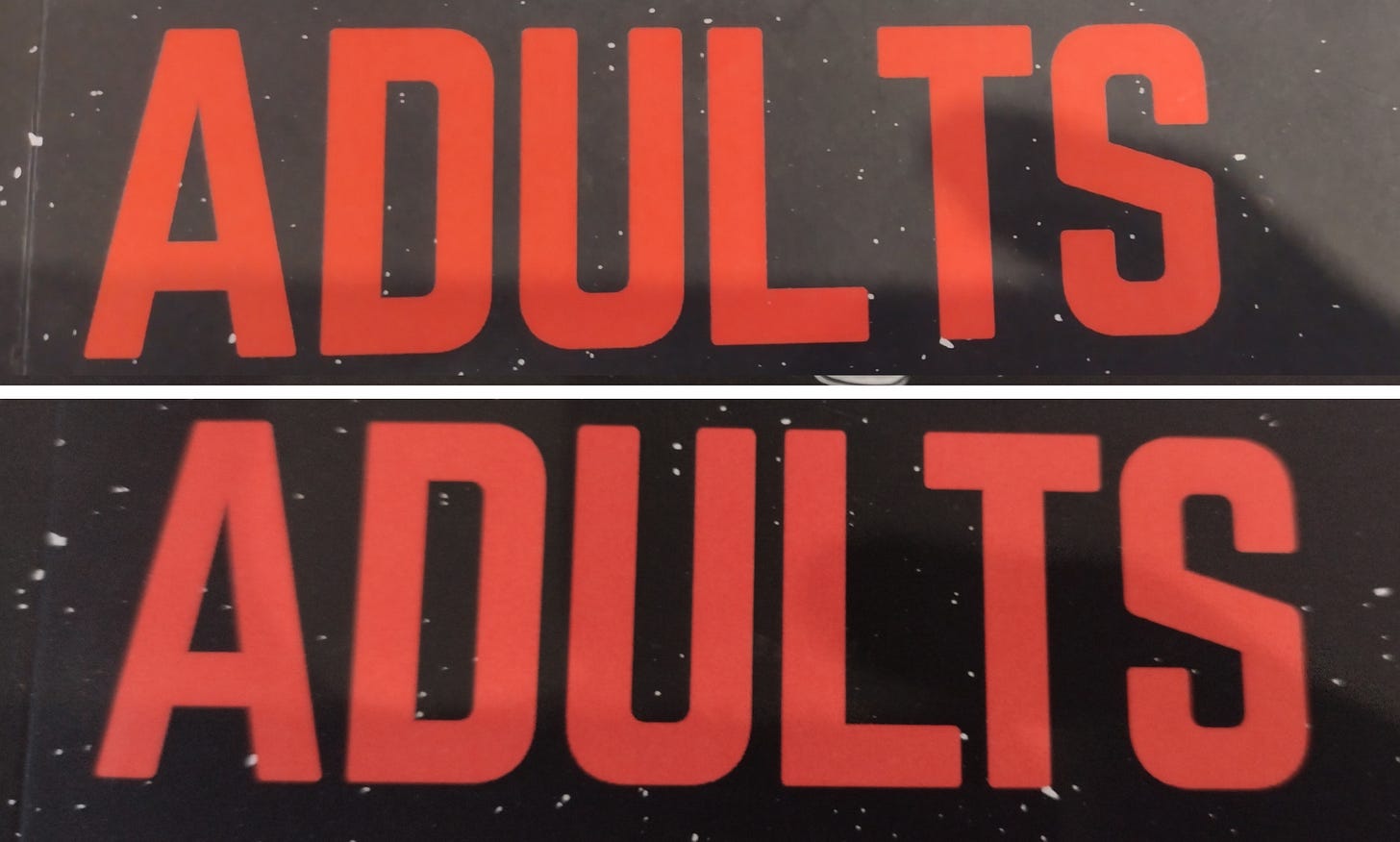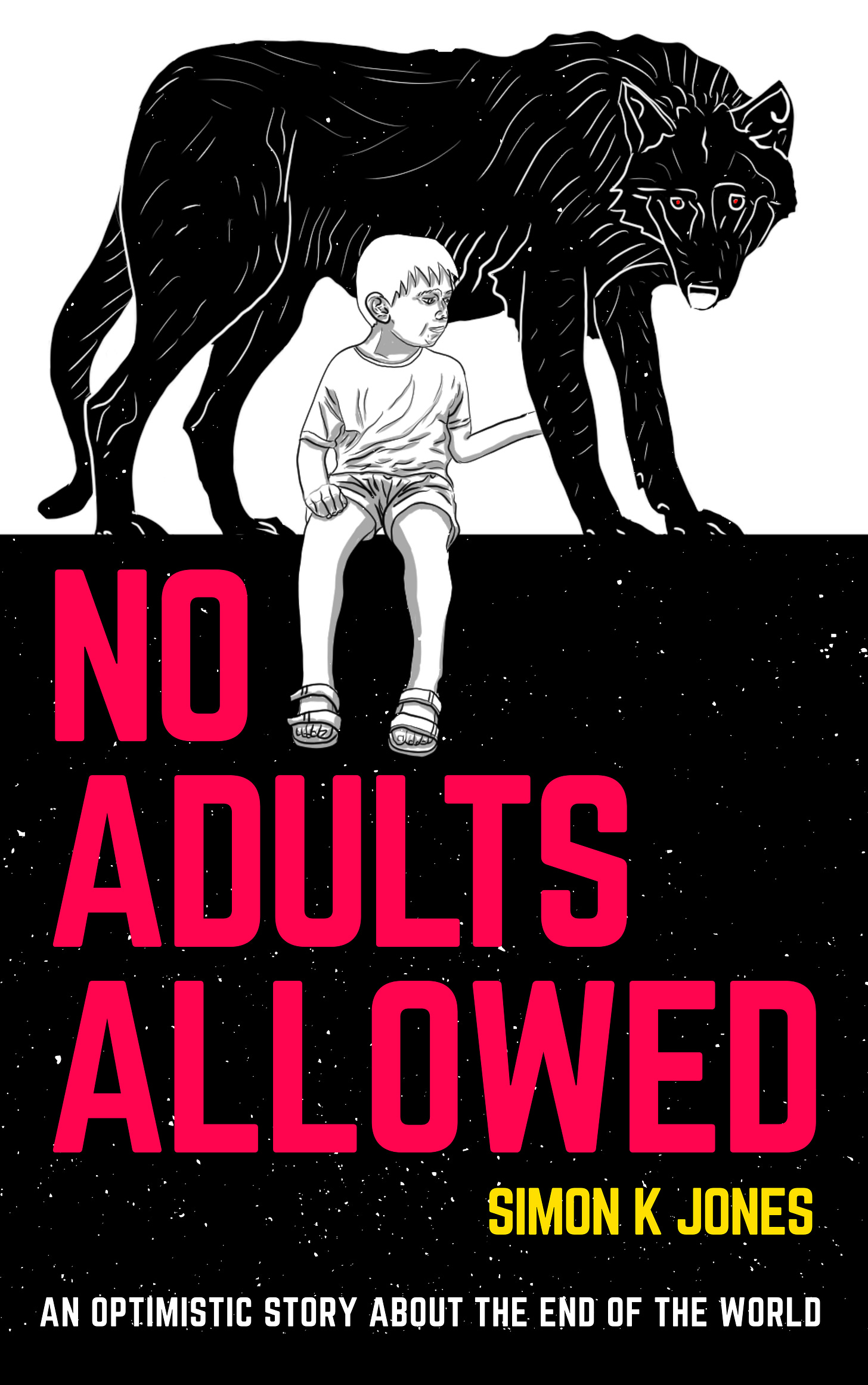I wrote this post over the weekend and it was essentially an announcement that my book No Adults Allowed is available for pre-order. That didn’t quite feel right, though: it was a bit too much of a marketing piece, without any real benefit to all of you who read this newsletter.
Instead, I thought I’d do a dive into the final stages of self-publishing.
Pointing people to a book, an actual product, feels very different. ‘Buy my thing!’ I say, immediately feeling a bit awkward. It’s not like the 2022 winter is leaving any of us with much in the way of disposable cash. Perhaps it’s just my baked-in Britishness. Self-promotion comes more naturally to other writers.
Nevertheless, my book No Adults Allowed is coming out next week! There’s no getting around that. But let’s talk a bit about the final stages of prepping a book for self-publishing, with the aim of making this post interesting and useful rather than purely self-serving.
The final stages of publication
I’ve already written a couple of posts about the book’s production. Here’s one focusing on the process and especially the development of the cover:
And then here’s a post with me moaning about the editing process:
I hadn’t edited from a print proof before, and it’s been quite revelatory. Definitely something I’ll be building into my standard process from now on, as it makes it so much easier to spot mistakes and areas for improvement. I also now have a satisfying, unique edition of the book covered in pencil scribbles. Maybe decades from now that’ll be a prized artefact for a superfan.
The actual process was quite fiddly, though, and there must be ways to make it more efficient. Here’s what I did:
Went through the print proof, marking up anywhere that needed fixing or extra work. This was mostly typos, but also some minor copy upgrades. I marked with a long dash in the margin, making the edits easy to spot, and underlines/strikethroughs as needed.
I then had to transfer the edits into the digital projects. This was a bit of a faff due to me having to maintain two separate versions: the Scrivener master file, and the typeset interior created using Reedsy’s online editor. It would have been much easier if I’d had a single project to edit, but I’ve not been able to get Scrivener to output a high quality interior layout, which is what led me to Reedsy. There are better options on Mac (I hear good things about Vellum), but on PC the options are more limited.
Initially I went chapter-by-chapter, one at a time, but for the second half of the book I switched to focusing purely on the print proof. I marked up the entire thing, and only then went back to the computer to transfer. That seemed more efficient.
After that was all done, I re-exported the ebook file and print PDF from Reedsy, and uploaded them into Amazon KDP’s system.
I also made some minor alterations to the cover. Amazon’s cover designer is basic but does the job. There was a new version of the cover artwork with a tiny typographic tweak: the gap between the L and T was too big in the original version. You can see the original version at the top here, and the tweaked version below:
It was a tiny change, but I have a particular aversion to weird typography on self-published book covers and wanted to avoid it if at all possible.
I also made some minor adjustments to the spin and the blurb on the back. These can be adjusted directly in the Amazon cover designer, while the front cover I created using a mixture of Clip Studio Paint and Canva. The most useful feature of Amazon’s cover designer is that it automatically adjusts to the correct size of the book - the number of pages obviously impacts on the depth of the spine.
Pricing & platforms
The product itself was ready, so the next step was to finalise the listings and pricing. This is where I encountered an interesting quirk in Amazon’s age system.
During initial setup I’d chosen the category of Juvenile fiction → science fiction. The book is loosely YA and is intended to be read by young readers as well as old. If it was a movie, it’d be a 12+.
The problem is that you then have to specify an age range, with a minimum and a maximum. In theory this is fine - I selected 14 for minimum (just to avoid any grumpy parents) and 18+ as the maximum. Sorted! Except, not: on the public-facing product page, Amazon doesn’t show the upper limit as ‘18+’ but as a straight ‘18’. Which makes it look very much like it’s not a book for anyone older than 18.
Hm.
The only way around was to re-categorise and avoid the ‘juvenile fiction’ label altogether. As such, it now sits in the Fiction → Science fiction → apocalyptic/post-apocalyptic and Fiction → Coming of age categories.
My takeaway from that is that unless your book is specifically aimed only at children, the best bet is to go broader with the fiction categories.
I was very unsure around pricing, having not done this before. After comparing with other books, on and off Amazon, and consulting with some author friends, I settled on £2.99 for the ebook and £7.99 for the paperback. I still wonder if these prices are a little on the high side for a relatively unknown author: but I also believe writers should value their work. We’ll see how it goes.
Promotion
As Twitter tears itself apart and Meta focuses on building stuff nobody wants, this newsletter has increasingly been a stable rock in a stormy sea. The turbulence in online communications makes it increasingly complicated for independent creatives trying to reach people who would be interested in their work.
It really helps to know that there’s already 1000+ subscribers on my newsletter, who I can talk to directly without being thwarted by obtuse corporate algorithms.
I’ve drastically cut my personal use of Twitter and Facebook and it’s quite startling how that seems to reduce the options for promotion. However, I sense that might be an illusion - neither of those platforms have ever been especially useful for me in terms of my writing. Finding readers has happened on reading platforms, whether it be Wattpad, Royal Road or here on Substack.
There's a lot of noise on social media platforms, but very little of it is useful.
What I’m hoping is to find more natural ways to promote the book: podcasts, blogs, interviews, newsletters. A bit more old school. A bit more honest, maybe.
I’ll let you know how it goes.
I should probably tell you a bit about the book, right? Have I been helpful enough to earn a few hundred words of self-promotion? Let’s see.
What is No Adults Allowed?
It’s an optimistic story about the end of the world.
Here’s the cover:
And here’s the blurb:
The grown-ups are all gone.
Harry, Eva and Flick live in a strange utopia: resources are plentiful, the climate has stabilised, there is peace. Their village is watched over by an invisible force keeping them all from danger - but is it protecting them, or hiding the truth?
A science fiction road trip about responsibility, family and change.
The ebook is £2.99 and the paperback is £7.99. You can pre-order the ebook now, or wait for the paperback to be available on Monday 28 November. It will be available in all major territories supported by Amazon.
No Adults Allowed is about lots of things, but primarily growing up, parental responsibility, youth activism and how adults have repeatedly failed the upcoming generations. Oh, and big tech and AI.
If I had to compare it to something else, I’d probably say that it’s Lord of the Flies meets Apocalypse Now, but written by someone who thinks kids are cool.
Key theme: Old people are rubbish
I include myself in that mass generalisation, for the record.
This was my 2020 project, written during the height of the pandemic. The idea had been buzzing around my head for many years, though, at least since 2016. My increasing frustrating with the old men running the world combined with my admiration for young activists.
A story formed.
It’s actually my third novel, despite being the first to appear in ebook/print form. My previous project, The Mechanical Crown, had been an epic three year serialisation that nearly killed me, so I was determined to put something out that was concise and focused. No Adults Allowed was designed from the start to be lean and sharp, taking its cues from classic sci-fi from the mid-20th century like The Drowned World and I Am Legend.
To make sure I stuck to the plan, I adopted a fairly extreme chapter numbering policy. Each chapter was numbered but in reverse order. The story begins with chapter 29 and counts down from there, towards zero. The reader doesn’t know why or what’s going to happen. It adds background tension for the reader and forced me to stay really on point. The length of the story couldn’t flex, because it had that ground zero mark to hit at the end.
It’s gone through a couple of drafts since, plus the final pass in preparation for this new launch. The ebook and paperback are the first time it’s been presented as a completed novel, which is exciting - I can’t wait to see readers encounter it in this form.
Pre-order now available!
No Adult Allowed is an exciting, thought-provoking book that doesn’t waste your time. If you would like to order the ebook you can do so here:
If you’re after the paperback, it’ll be available on those same links on Monday 28 November.
It’s thrilling and terrifying to think that the book will exist on people’s actual shelves in only a couple of weeks.
Thanks, as always, for your time and support.






And congrats on the book! Self publishing is no easy feat! And editing isn’t easy either. Bravo.
As far as tools for PC go, I have used Affinity Publisher for three books now and I'm very pleased with the result. It's a powerful tool so there is a learning curve, but it works well, including doing things like ligatures and kerning automatically, which would address that kerning issue on your cover. I used it for both the interior and the cover. There's a lot of good info on line and an active and responsive community so I never got stuck on how to do something.